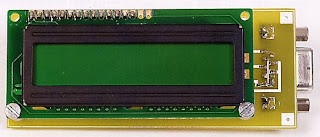With the constant evolution of PC performance, you are more likely to use "old" machines for applications such as automation, data acquisitions or even measures of all kinds. Such applications have rarely need the TV monitor when digital data display only a few or a few lines of text. I suggest you do without connecting on one of the serial ports of your PC this interface, equipped with a classic LCD alphanumeric display one or two lines of sixteen or twenty characters.
It can be connected to the standard serial port of any PC compatible and is fitted with a standard 9-pin connector for the use of any conventional straight cable trade.
Given the low consumption of the used controller circuit, it takes its power on the PC serial port.Finally, the circuit that I drew is as wide as the displays to one or two lines of sixteen standard characters, the back of which they can be assembled and connected directly.
The MIC 702 of Mictronics
To transform a LCD standard parallel interface serial interface model, use a microcontroller or a dedicated circuit as the MIC 702 Mictronics you can download the complete data sheet and in French by clicking on this link. It is a circuit specifically designed to transform a parallel interface logic integrated LCD display in standard asynchronous serial interface. Its implementation is very simple as shown in the diagram below.
PC side, the connection to the serial output of the PC does not use any level converter RS 232 in TTL; this role being played by the only 22-ohm resistor R1 whose presence is indispensable.

The BAUD tab allows you to choose the speed of the circuit among two speeds: 9600 with S1 or 2400 baud up with S2 in place. The POL tab allows the system to interpret the data series under direct or inverted form. As is in direct RS 232 must connect this tab to ground to indicate that the MIC 702 receives inverted data. A link to +5 volts would allow it to receive direct information as would be the case if one wanted to use this circuit with a Basic Stamp for example. Subject to use a non-backlit display, the total consumption of mounting is low enough that it can take its power directly from the outputs of the RS control signals 232. It is the role of the diodes D2 and D3 associated with IC1, which is a low dropout regulator and low consumption. If you care to use a backlit display, it is possible that consumption of the backlight only exceeds the capabilities of the PC serial port. You can then use an external power supply via the diode D1. A voltage of 9 volts at a rate of one hundred mA appropriate.
It can be connected to the standard serial port of any PC compatible and is fitted with a standard 9-pin connector for the use of any conventional straight cable trade.
Given the low consumption of the used controller circuit, it takes its power on the PC serial port.Finally, the circuit that I drew is as wide as the displays to one or two lines of sixteen standard characters, the back of which they can be assembled and connected directly.
The MIC 702 of Mictronics
To transform a LCD standard parallel interface serial interface model, use a microcontroller or a dedicated circuit as the MIC 702 Mictronics you can download the complete data sheet and in French by clicking on this link. It is a circuit specifically designed to transform a parallel interface logic integrated LCD display in standard asynchronous serial interface. Its implementation is very simple as shown in the diagram below.
Scheme
The MIC 702 is connected directly to the display with which it is perfectly compatible. Note liaison with only 4 significant bits of data since the MIC 702 operates in the display mode 4 bits twice.PC side, the connection to the serial output of the PC does not use any level converter RS 232 in TTL; this role being played by the only 22-ohm resistor R1 whose presence is indispensable.
The BAUD tab allows you to choose the speed of the circuit among two speeds: 9600 with S1 or 2400 baud up with S2 in place. The POL tab allows the system to interpret the data series under direct or inverted form. As is in direct RS 232 must connect this tab to ground to indicate that the MIC 702 receives inverted data. A link to +5 volts would allow it to receive direct information as would be the case if one wanted to use this circuit with a Basic Stamp for example. Subject to use a non-backlit display, the total consumption of mounting is low enough that it can take its power directly from the outputs of the RS control signals 232. It is the role of the diodes D2 and D3 associated with IC1, which is a low dropout regulator and low consumption. If you care to use a backlit display, it is possible that consumption of the backlight only exceeds the capabilities of the PC serial port. You can then use an external power supply via the diode D1. A voltage of 9 volts at a rate of one hundred mA appropriate.
